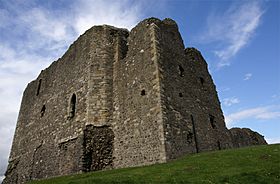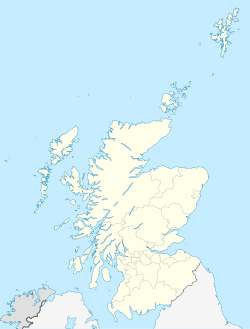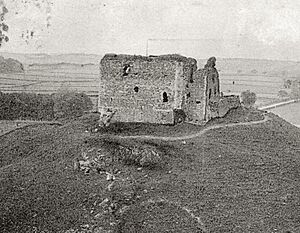Dundonald Castle facts for kids
Quick facts for kids Dundonald Castle |
|
|---|---|
| Dundonald, South Ayrshire, Scotland | |

From south west
|
|
| Coordinates | 55°34′37″N 4°35′50″W / 55.57681°N 4.5972°W |
| Site information | |
| Open to the public |
Yes |
| Condition | Ruin |
Dundonald Castle sits on a hill overlooking the village of Dundonald. This village is located between Kilmarnock and Troon in South Ayrshire, Scotland. Dundonald Castle is a strong tower house. It was built for Robert II when he became King of Scotland in 1371. Both Robert II and his son Robert III used it as a royal home.
Contents
The Castle's Story
Ancient Hill Fort
The castle you see today stands on a very old site. Long ago, there was a hill fort here. People believe it had large roundhouses and other buildings made of timber. A strong wall of stone and wood protected the fort.
This wall caught fire around 1000 AD. The fire was so hot that the stones melted, a process called vitrification. This event likely marked the end of the hill fort. Around this time, the British Kingdom of Strathclyde became part of the Kingdom of Scotland.
The name Dundonald means "fort of Donald." It comes from an old British language. The "Donald" part might refer to one of the many kings of Strathclyde named Dyfnwal.
First Castles on the Hill
Three different medieval castles have stood on this spot. The first was built around 1136. It was likely built by Walter, the first steward of the Scottish king. We can't see any parts of this castle today.
The second castle was built in the late 1200s by Alexander Stewart. This castle was mostly made of stone. It was one of the grandest homes for a noble family back then. However, the Scottish army largely destroyed it in the early 1300s. This happened during the Wars of Scottish Independence. King Robert the Bruce had a policy to demolish castles. This stopped enemies from using them. Only a well and a rounded tower stump remain from this castle.
The Castle We See Today
The third castle was built by Robert Stewart. He probably built it to celebrate becoming King Robert II in 1371. This castle had three floors.
The top floor was the great hall. This was a private space for the king and his family. The first floor was the lower hall. It was used for public events like feasts and court meetings. The ground floor was for storage. It likely held wine, ale, food, and fuel.
The tower house was made bigger in the late 1300s. New rooms were added, along with a prison. An outer courtyard, called a barmkin, was also finished. Other buildings like stables, bakeries, and a blacksmith's shop were built against its wall.
Most of what you see of Dundonald Castle today, including the tall tower, comes from this third castle. The castle also had its own chapel, dedicated to Saint Inan.
Later Owners and Changes
By 1520, the Wallace family owned the castle. In 1536, King James V gave the castle to Robert Boyd. But Boyd could not take control from the Wallaces. The Wallaces later moved their main home to Auchans House. They built Auchans House in the 1580s, using some materials from Dundonald Castle.
In 1632, the Wallaces had to sell Dundonald Castle because of money problems. Sir William Cochrane bought it in 1638. He also bought Auchans House.
In 1669, Cochrane became the first Earl of Dundonald. This was because he supported the Royalist side in the Wars of the Three Kingdoms. In 1726, the Cochranes sold the Dundonald estate. But they kept the ruined castle. In 1953, the 13th Earl gave the castle to the state. Work then began to rebuild parts of it.
Visiting Dundonald Castle Today
At the bottom of the hill, there is a visitor centre. It has a cafe, a gift shop, and an exhibition. The exhibition shows the history of the castle and the older buildings on the site. It includes detailed models of the earlier castles.
South Ayrshire Council owns the visitor centre. Historic Scotland owns the castle. The Friends of Dundonald Castle group manages both the castle and the visitor centre. The castle became a protected historical site in 1920.
Archaeological Discoveries
Archaeologists have studied Dundonald Castle many times. In the 1960s, small digs showed that the castle's base was very deep. It rested on solid rock.
Between 1986 and 1988, bigger excavations took place. These digs were done before conservation work began. More small digs happened until 1993. These studies focused on the area inside the castle's outer courtyard. They found items from many different time periods, going back to the Bronze Age.
Some of the things found include:
- Layers of charcoal, possibly from the Neolithic period.
- Structures like kilns and pieces of Bronze Age pottery. This suggests people lived here for a long time.
- Grains like emmer wheat. These grains can be found at sites from the Neolithic to the Iron Age.
- Evidence of an Iron Age Hillfort. This included large wooden roundhouses. People lived in these houses for a long time.
- Bracelets made of shale or lignite and glass beads. These suggest the settlement continued into the 4th and 5th centuries AD.
In 2017 and 2018, Historic Environment Scotland (HES) worked with the Friends of Dundonald Castle. They wanted to help more people learn about the castle. They hoped new studies would show how the site developed over time.
In early 2017, a geophysical survey was done. This survey used special equipment to look underground without digging. Then, in August 2018, archaeologists from HES and CFA Archaeology carried out new excavations.
The Legend of Donald Din
There is an old Scottish folktale about how Dundonald Castle was built. It tells of a hero named Donald Din.
The story says Donald Din was a poor man. But he had dreams that told him where to find good luck. One night, he dreamed three times that he would become rich if he went to London Bridge. So, he went there.
He met a stranger on the bridge. Donald told the stranger about his dream. The stranger said he had a similar dream once. His dream told him to go to a certain spot in Ayrshire, Scotland, to find treasure. But the stranger had never bothered to go.
Donald realized the stranger was describing his own humble garden back home! He quickly went back. He dug up his garden, even though his wife thought he was crazy. He found a large pot full of gold coins. With this gold, he built a strong castle for himself. He became the founder of a successful family.
Where the Legend Comes From
Similar legends are found all over Europe and the Middle East. One of the earliest versions is a poem from the 13th century. It was written by the Persian poet Jalal al-Din Rumi. This poem became a story in The One Thousand and One Nights, called The man who became rich through a dream. This story then spread through many countries as folklore and children's tales. More recently, the story was used in the book The Alchemist by Paulo Coelho.
Images for kids






